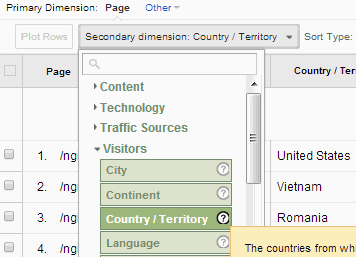Secondary Dimension in Google Analytics: Unlocking Advanced Metrics
Secondary Dimension in Google Analytics: Unlocking Advanced Metrics
Blog Article
Enhance Your Information Evaluation Making Use Of Secondary Dimension in Google Analytics
Exploring the capabilities of additional measurements in Google Analytics opens up a world of opportunities for refining information evaluation. The capability to explore info additionally past the surface area degree provides a nuanced sight that can form strategic decisions. By layering extra measurements onto main information sets, an even more detailed story arises, shedding light on customer interactions and efficiency signs. This dynamic approach to data assessment holds the vital to unlocking concealed patterns and fads that can change just how companies interpret their electronic footprint.
Comprehending Secondary Dimensions
Second dimensions in Google Analytics refer to extra parameters that can be added to the primary measurement, permitting for an extra detailed analysis of data (Secondary Dimension in Google Analytics). By incorporating secondary dimensions, analysts can segment and filter data to uncover patterns, trends, and connections that could not be apparent when looking at the data as a whole.

Advantages of Using Second Measurements
When examining data in Google Analytics, the use of second measurements uses very useful understandings into user behavior and performance metrics. By including a secondary dimension to your main information, you can dive deeper into the attributes of your site visitors and their interactions.
In addition, secondary dimensions improve the context of your main information, providing a much more comprehensive view of customer interaction and efficiency metrics. Overall, the usage of additional dimensions in Google Analytics can significantly boost the deepness and top quality of your information analysis, leading to even more enlightened decision-making and enhanced results.
Exactly How to Include Additional Measurements
By including secondary dimensions in Google Analytics, individuals can get deeper insights right into their data evaluation procedure, permitting even more detailed examination of user actions and performance metrics. Adding second dimensions is a straightforward procedure that can substantially boost the deepness of evaluation. To add a secondary measurement in Google Analytics, begin by navigating to the record you desire to assess. Once in the report, locate the "Second measurement" tab over the information table. Click on it to disclose a dropdown menu with numerous alternatives such as Actions, Modern Technology, and Custom-made Capacities. Select the measurement you want to add, such as 'Source/Medium' or 'Gadget Group'. This additional measurement will after that be applied to your existing data, providing added context and permitting for an extra thorough analysis of customer communications. By making use of additional dimensions successfully, users can discover useful understandings that might have otherwise been overlooked, causing educated decision-making and enhanced performance approaches.
Analyzing Information With Second Dimensions
Utilizing additional dimensions in data analysis offers an extra detailed understanding of customer habits and performance metrics. By adding an additional measurement to your primary data established in Google Analytics, you can delve much deeper into the features of your web site site visitors and their interactions. Integrating the primary measurement of 'source/medium' with the second measurement of 'landing page' can reveal which particular web pages are drawing in website traffic from different resources, aiding you enhance these pages for much better engagement.

In essence, analyzing data with secondary measurements encourages you to obtain here beneficial understandings into customer behavior, recognize patterns, and make informed choices to improve the performance of your electronic properties.
Best Practices for Second Dimensions
In information analysis, incorporating second dimensions effectively can considerably enhance the deepness of understandings derived from metrics and customer actions patterns. When making use of secondary measurements in Google Analytics or any various other visit the site logical tool, it is critical to follow ideal techniques to make sure the precision and significance of the information evaluation.
One key ideal method is to very carefully pick second dimensions that enhance the primary measurement being evaluated. Choosing secondary dimensions that offer added context or more segmentation can offer a much more comprehensive understanding of the data. It is also important to prevent overcomplicating the analysis by consisting of as well numerous second measurements, which may cause confusion or dilution of understandings.
Additionally, it is advisable to explore various mixes of main and second dimensions to discover brand-new relationships and patterns. Routinely evaluating and improving the selection of secondary dimensions based on the particular objectives of the analysis can bring about more actionable understandings. By following these finest practices, information analysts can utilize additional dimensions successfully to enhance the total data analysis procedure and decision-making abilities.

Final Thought
To conclude, including second measurements in Google Analytics is essential for an extensive data analysis method. By leveraging additional measurements together with key ones, marketing professionals and experts can uncover important understandings and connections that can notify decision-making and optimize digital marketing approaches. Understanding how to efficiently make use of secondary dimensions and adhering to finest methods will permit experts to remove purposeful information and improve their general efficiency metrics.
Additional measurements in Google Analytics refer to extra parameters that can be added to the main measurement, permitting visit this site for a much more in-depth analysis of information. By integrating secondary measurements, analysts can segment and filter information to discover patterns, fads, and relationships that may not be apparent when looking at the information as a whole. Integrating the primary measurement of 'source/medium' with the second measurement of 'touchdown page' can expose which certain pages are drawing in website traffic from different sources, aiding you maximize these pages for better involvement.
One secret ideal practice is to carefully pick additional dimensions that enhance the main dimension being evaluated. By following these ideal methods, data analysts can leverage secondary measurements efficiently to enhance the overall data analysis process and decision-making abilities.
Report this page